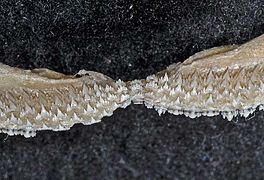
The kitefin shark or seal shark is a species of squaliform shark in the family Dalatiidae, and the type species in its genus. It is found sporadically around the world, usually close to the sea floor at depths of 200–600 m (660–1,970 ft). With a sizable oil-filled liver to maintain neutral buoyancy, this shark is able to cruise slowly through the water while expending little energy. The kitefin shark, the largest luminous vertebrate on record, has a slender body with a very short, blunt snout, large eyes, and thick lips. Its teeth are highly differentiated between the upper and lower jaws, with the upper teeth small and narrow and the lower teeth large, triangular, and serrated. Its typical length is 1.0–1.4 m (3.3–4.6 ft), though examples as long as 5.9 ft (180 cm) have been encountered.

Parmaturus is a genus of deepwater catsharks in the family Pentanchidae. Four species were described in 2007 and another in 2019 with more species likely to be described in the near future.

The lollipop catshark is a little-known species of shark belonging to the family Pentanchidae, the deepwater catsharks, and the only described member of its genus. A diminutive, bottom-dwelling shark of the outer continental shelf and upper continental slope, this species can be readily identified by its tadpole-like shape with a greatly expanded, rounded head and narrow body. The large head houses expanded gills, which are thought to be an adaptation for hypoxic conditions. This shark preys on crustaceans and fishes. Reproduction is aplacental viviparous, with females retaining egg cases internally two at a time until they hatch. There is no fishery interest in this species.

The white-spotted Izak or African spotted catshark is a species of shark belonging to the family Pentanchidae, the deepwater catsharks. It is found in the western Indian Ocean off the coasts of Natal, South Africa, southern Mozambique, Madagascar, Kenya, and Tanzania between latitudes 4° S and 37° S, at depths of between 220 and 440 m. It can grow up to 35 cm in length.
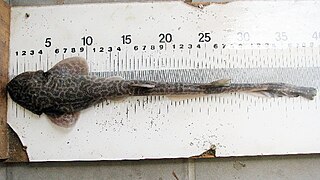
The Izak catshark or simply Izak is a species of shark belonging to the family Pentanchidae, the deepwater catsharks. This species is common off the coasts of South Africa and southern Namibia. It typically inhabits the outer continental shelf at depths of 100–300 m (330–980 ft), with the males found deeper than the females and juveniles. The Izak catshark has a short, wide, flattened head and a robust body tapering to a long, slender tail. It can be identified by its ornate color pattern of dark brown spots or reticulations and blotches on a light yellowish background, as well as by the enlarged dermal denticles over its pectoral fins and along its dorsal midline from the snout to the second dorsal fin. This species reaches 69 cm (27 in) in length, with the males larger than females.

The Caribbean roughshark is a rough shark of the family Oxynotidae, found on the upper continental slopes of the Caribbean Sea, at depths between 400 and 450 m. It reaches a length around 50 cm (20 in).
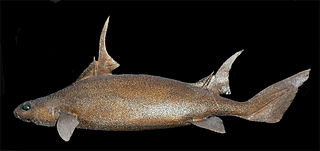
The sailfin roughshark is a species of dogfish shark in the family Oxynotidae, found in the eastern North Atlantic from Scotland to Senegal between latitudes 61°N and 11°N, at depths of between 265 and 720 m. Its length is up to 1.2 m (3.9 ft).
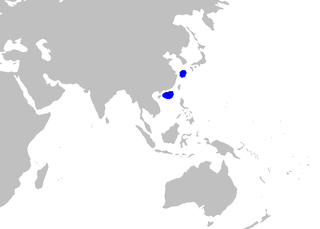
The blackgill catshark or blackgill bristle shark is a deep water catshark known from very few specimens, found on or near the bottom on the continental slope, at 540–835 metres (1,772–2,740 ft) off the coasts of China and Japan. Specimens can attain a total length of at least 85 cm (33 in), have elongated cat-like eyes, and have two small dorsal fins set far back. They’re oviparous and lay one egg at a time. This shark is a potential bycatch of deep water bottom-trawl fisheries operating within its range, but no specific information is available. In the upper jaw, there are rods of blunt, flat teeth with 3 cusps, likely used for crushing, as well as row of sharper teeth with the mid, central cusp longer and to a point. The bottom teeth are sharp, pointed, jagged and have three cusps, with the middle cusp slightly longer than the surrounding two.
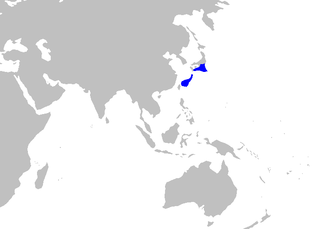
The salamander shark or salamander catshark is a species of shark belonging to the family Pentanchidae, the deepwater catsharks. This species inhabits a range from Japan and the East China Sea, on the upper to middle continental slope at depths of 358–895 m. Specimens of this species can attain a total length of at least 64 cm. This catshark is a potential bycatch of trawl fisheries operating within its range, but no details are available. There are high levels of squalene in this catshark's liver. The reproduction of this catshark is oviparous.

The quagga catshark is a species of shark belonging to the family Pentanchidae, the deepwater catsharks. A small, slim-bodied shark reaching 37 cm (15 in) in length, it has a distinctive color pattern of narrow, dark brown vertical bars, which resemble those of the quagga. Its head is short and flattened, with a pointed snout tip that is not upturned.

The blackmouth catshark is a species of deepwater catshark, belonging yo the family Pentanchidae, common in the northeastern Atlantic Ocean from Iceland to Senegal, including the Mediterranean Sea. It is typically found over the continental slope at depths of 150–1,400 m (490–4,590 ft), on or near muddy bottoms. The youngest sharks generally inhabit shallower water than the older juveniles and adults. This slim-bodied species is characterized by the black interior of its mouth, a marbled pattern of pale-edged brownish saddles or blotches along its back and tail, and a prominent saw-toothed crest of enlarged dermal denticles along the upper edge of its caudal fin. It reaches lengths of 50–79 cm (20–31 in), with sharks in the Atlantic growing larger than those in the Mediterranean.
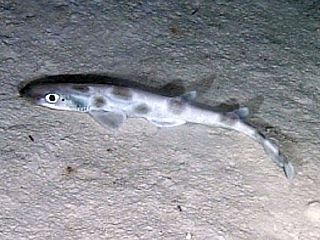
The roughtail catshark or marbled catshark is a common species of deepwater catshark, belonguing to the family Pentanchidae. It is found at a depth of 36–702 m (118–2,303 ft) in the northwestern Atlantic Ocean, the Gulf of Mexico, and the Caribbean Sea, from North Carolina to Costa Rica. Individuals of different sexes and ages are segregated to some degree. A small species not exceeding 33 cm (13 in) in length, the roughtail catshark has a slender body with a marbled color pattern of dark saddles and spots, and a prominent crest of enlarged dermal denticles along the dorsal edge of its caudal fin. This species feeds mainly on shrimp and is oviparous. It is caught incidentally in shrimp trawls, though trawl fisheries within its range mostly do not operate at the depths it inhabits. As a result, the International Union for Conservation of Nature has listed it under Least Concern.

The Australian sawtail catshark is a common species of deepwater catshark, belonging to the family Pentanchidae, endemic to southern Australian waters. It is found on or near the bottom of the outer continental shelf and upper continental slope, at depths of 85 to 823 m. This slim-bodied species is characterized by crests of enlarged dermal denticles along both the dorsal and ventral edges of its caudal fin and caudal peduncle, along with a color pattern of broad, dark saddles outlined in white. It can grow to 61 cm (24 in) in length. The Australian sawtail catshark feeds mainly on fishes, crustaceans, and cephalopods. Females are oviparous and lay eggs enclosed by capsules. This species is often caught incidentally by commercial bottom trawl fisheries, but is not significantly threatened by fishing activity. Thus, it has been assessed as of Least Concern by the International Union for Conservation of Nature (IUCN).

The longfin sawtail catshark is a rare, little-known species of deepwater catshark., part of the family Pentanchidae. Once thought to be a subspecies of the roughtail catshark along with the Antilles catshark, it inhabits deep water off the Caribbean coasts of Panama and Colombia. This slim-bodied species has a marbled dorsal color pattern and a prominent crest of enlarged dermal denticles along the dorsal edge of its caudal fin. It can be distinguished from similar species by its relatively longer anal fin and small adult length of under 35 cm (14 in). The longfin sawtail catshark is oviparous.

The African sawtail catshark is a species of shark belonging to the family Pentanchidae, the deepwater catsharks. Demersal in nature, it is found at depths of 160–720 m (520–2,360 ft) off the western African coast from Morocco to South Africa. This slender species has a rather long, pointed snout, a series of dark saddles along the back and tail, and a prominent crest of enlarged dermal denticles along the upper edge of the caudal fin. Its maximum known length is 46 cm (18 in).

The blacktip sawtail catshark is a species of shark belonging to the family Pentanchidae, the deepwater catsharks, This species is found off the coasts of Taiwan and the Philippines. It is demersal in nature and occurs deeper than 60 m (200 ft). Growing up to 46 cm (18 in) long, this slim-bodied species is characterized by its plain brownish dorsal coloration with dark tips on the dorsal and caudal fins, and a prominent crest of enlarged dermal denticles on the upper edge of the caudal fin. It is oviparous, with females producing encapsulated eggs two at a time year-round. The blacktip sawtail catshark is caught incidentally in bottom trawls and used for fishmeal in Taiwan.
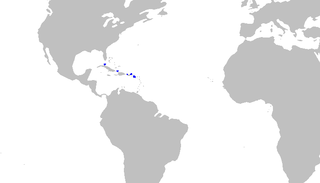
Springer's sawtail catshark is a species of shark belonging to the family Pentanchidae, the deepwater catsharks. This shark is found in waters 457–699 m (1,499–2,293 ft) deep off the islands of the Antilles, from Cuba to the Leewards. A small, slim-bodied species reaching a length of 48 cm (19 in), the Springer's sawtail catshark can be identified by its color pattern of horizontal dark stripes in front of the first dorsal fin, and dark dorsal saddles behind. It is additionally characterized by the presence of saw-toothed crests, made of enlarged dermal denticles along both the dorsal and the ventral edges of the caudal fin. The Springer's sawtail catshark is oviparous.
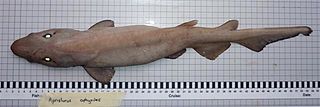
The white ghost catshark is a shark of the catshark family Pentanchidae, the deepwater catsharks. This shark is found in deep water in the northeast Atlantic between latitudes 57°N and 58°N. A deep-water catshark known from the eastern North Atlantic from depths of 1,014 to 1,800 m, it is known from only a limited number of specimens. It reaches a maximum of 54 cm or 1.7 ft total length which is a medium size for the Apristurus genus.
Figaro is a genus of shark, and part of the family Pentanchidae, the deepwater catsharks. Until 2008, Figaro was generally considered to be a subgenus of Galeus, the sawtail catsharks. The two known species are found off Australia, inhabiting deep, offshore waters on or near the bottom. Figaro contains small, slender, firm-bodied sharks that bear distinctive crests of enlarged, spiny dermal denticles along the dorsal and ventral edges of their short caudal fins. The caudal peduncle is relatively long, such as that the anal and caudal fins are some distance apart. In adult males, the inner margins of the pelvic fins are fused together to form a subtle "apron" over the claspers. F. boardmani is a predator of fishes, crustaceans, and cephalopods, and is oviparous; less is known about the F. striatus. Both are harmless and are of no economic importance.

The Brazilian filetail catshark is a species of shark belonging to the family Pentanchidae, the deepwater catsharks, found in southern Brazil. It lives on the continental slopes at the depths of 500–600 m (1,600–2,000 ft).




